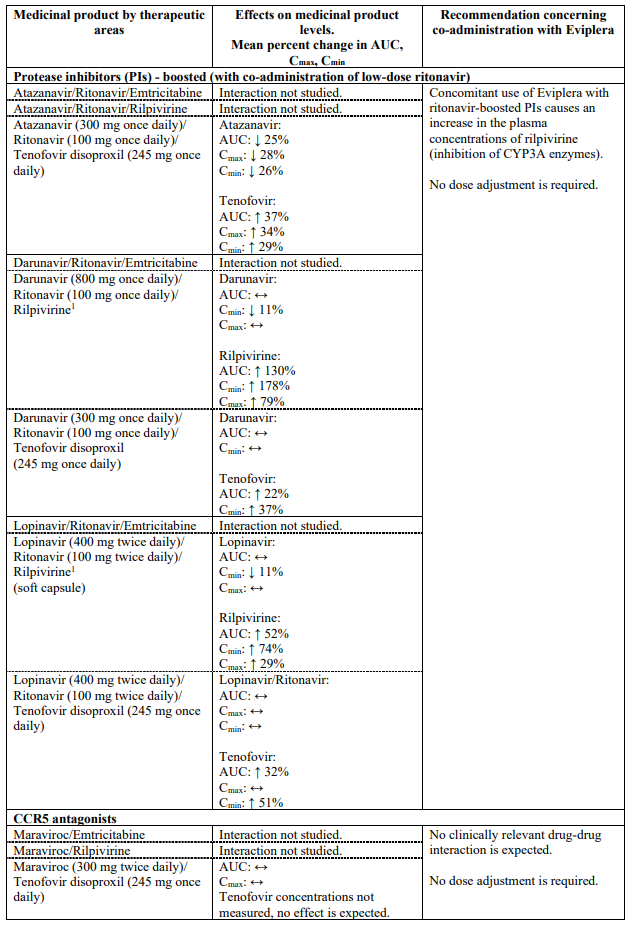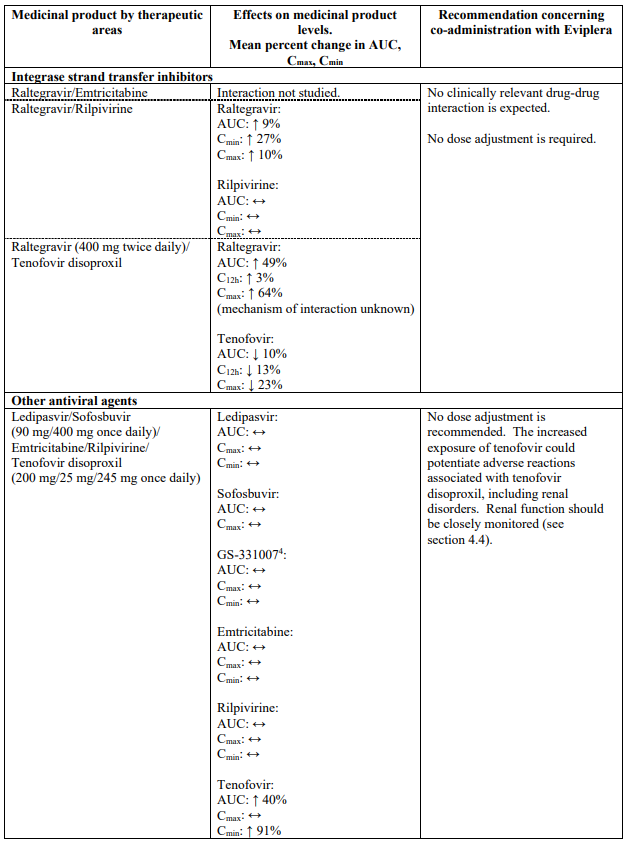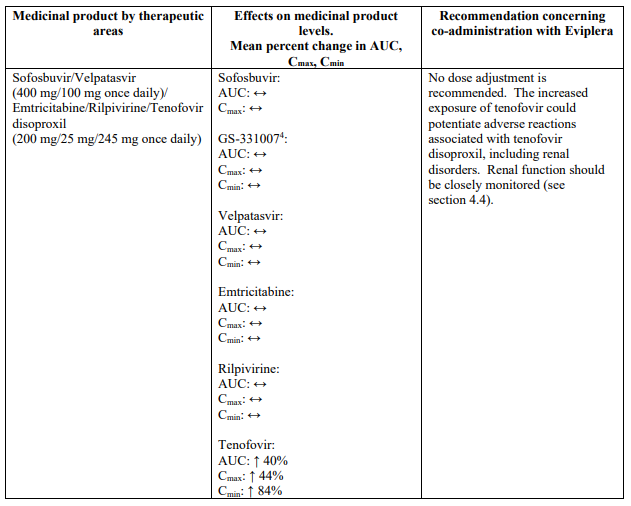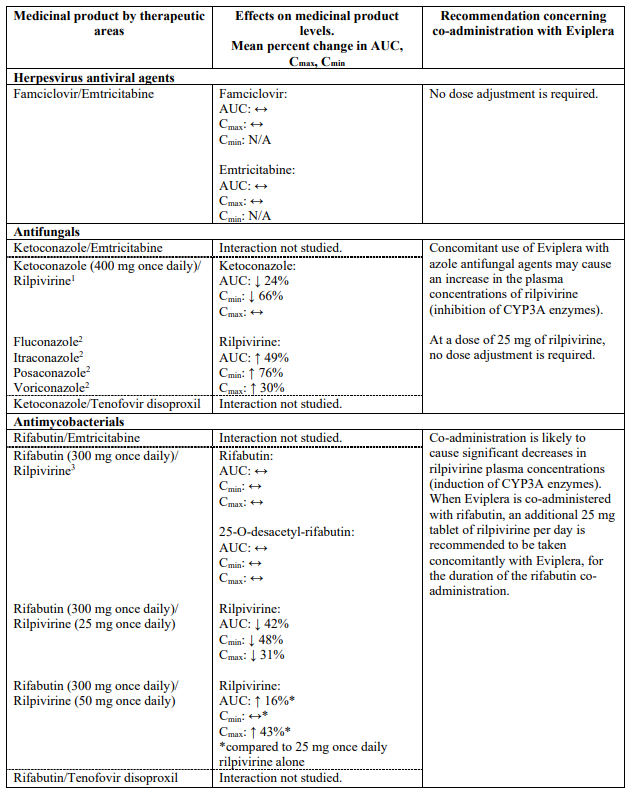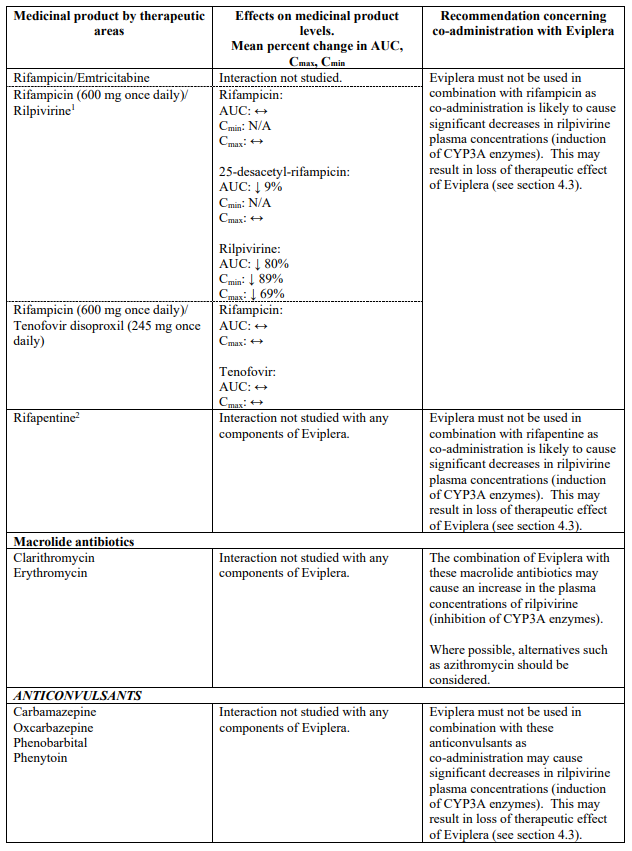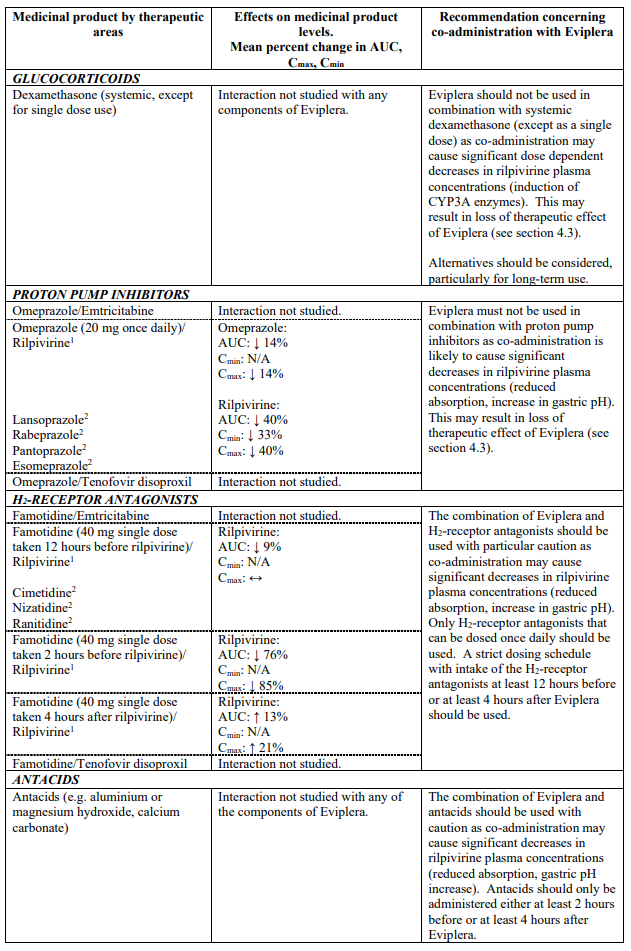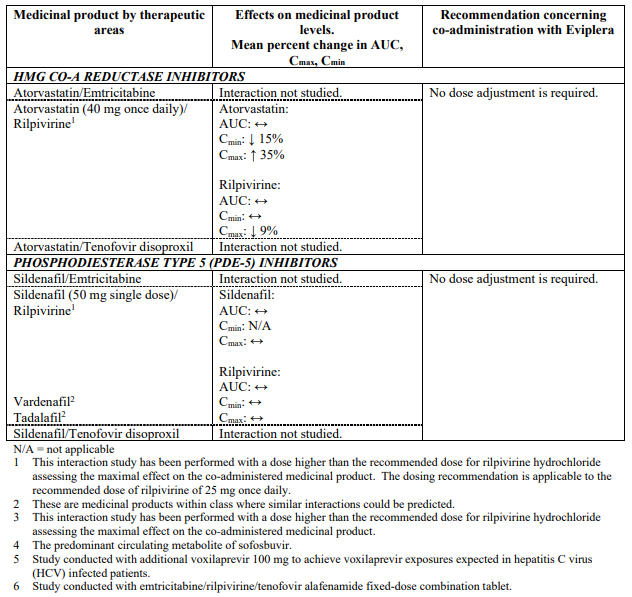EVIPLERA Film-coated tablet Ref.[107676] Active ingredients: Emtricitabine Emtricitabine, Tenofovir disoproxil and Rilpivirine Rilpivirine Tenofovir disoproxil
Source: European Medicines Agency (EU) Revision Year: 2022 Publisher: Gilead Sciences Ireland UC, Carrigtohill, County Cork, T45 DP77, Ireland
4.3. Contraindications
Hypersensitivity to the active substances or to any of the excipients listed in section 6.1.
Eviplera should not be co-administered with the following medicinal products as significant decreases in rilpivirine plasma concentrations may occur (due to cytochrome P450 [CYP]3A enzyme induction or gastric pH increase), which may result in loss of therapeutic effect of Eviplera:
- the anticonvulsants carbamazepine, oxcarbazepine, phenobarbital, phenytoin
- the antimycobacterials rifampicin, rifapentine
- proton pump inhibitors, such as omeprazole, esomeprazole, lansoprazole, pantoprazole, rabeprazole
- the systemic glucocorticoid dexamethasone, except as a single dose treatment
- St. John’s wort (Hypericum perforatum)
4.4. Special warnings and precautions for use
Virologic failure and development of resistance
Eviplera has not been evaluated in patients with previous virologic failure to any other antiretroviral therapy. There is not sufficient data to justify the use in patients with prior NNRTI failure. Resistance testing and/or historical resistance data should guide the use of Eviplera (see section 5.1).
In the pooled efficacy analysis from the two Phase III clinical studies (C209 [ECHO] and C215 [THRIVE]) through 96 weeks, patients treated with emtricitabine/tenofovir disoproxil + rilpivirine with a baseline viral load >100,000 HIV-1 RNA copies/mL had a greater risk of virologic failure (17.6% with rilpivirine versus 7.6% with efavirenz) compared to patients with a baseline viral load ≤100,000 HIV-1 RNA copies/mL (5.9% with rilpivirine versus 2.4% with efavirenz). The virologic failure rate in patients treated with emtricitabine/tenofovir disoproxil + rilpivirine at week 48 and week 96 was 9.5% and 11.5% respectively, and 4.2% and 5.1% in the emtricitabine/tenofovir disoproxil + efavirenz arm. The difference in the rate of new virologic failures from the week 48 to week 96 analysis between rilpivirine and efavirenz arms was not statistically significant. Patients with a baseline viral load >100,000 HIV-1 RNA copies/mL who experienced virologic failure exhibited a higher rate of treatment-emergent resistance to the NNRTI class. More patients who failed virologically on rilpivirine than who failed virologically on efavirenz developed lamivudine/emtricitabine associated resistance (see section 5.1).
Cardiovascular
At supratherapeutic doses (75 mg and 300 mg once daily), rilpivirine has been associated with prolongation of the QTc interval of the electrocardiogram (ECG) (see sections 4.5 and 5.1). Rilpivirine at the recommended dose of 25 mg once daily is not associated with a clinically relevant effect on QTc. Eviplera should be used with caution when co-administered with medicinal products with a known risk of Torsade de Pointes.
Co-administration of other medicinal products
Eviplera should not be administered concomitantly with other medicinal products containing emtricitabine, tenofovir disoproxil, tenofovir alafenamide, or other cytidine analogues, such as lamivudine (see section 4.5). Eviplera should not be administered concomitantly with rilpivirine hydrochloride unless needed for dose adjustment with rifabutin (see sections 4.2 and 4.5). Eviplera should not be administered concomitantly with adefovir dipivoxil (see section 4.5).
Co-administration of Eviplera and didanosine is not recommended (see section 4.5).
Renal impairment
Eviplera is not recommended for patients with moderate or severe renal impairment (CrCl <50 mL/min). Patients with moderate or severe renal impairment require a dose interval adjustment of emtricitabine and tenofovir disoproxil that cannot be achieved with the combination tablet (see sections 4.2 and 5.2). Use of Eviplera should be avoided with concurrent or recent use of a nephrotoxic medicinal product (see section 4.5). If concomitant use of Eviplera and nephrotoxic agents is unavoidable, renal function must be monitored weekly (see sections 4.5 and 4.8).
Cases of acute renal failure after initiation of high dose or multiple non-steroidal anti-inflammatory drugs (NSAIDs) have been reported in patients treated with tenofovir disoproxil and with risk factors for renal dysfunction. If Eviplera is co-administered with an NSAID, renal function should be monitored adequately.
Renal failure, renal impairment, elevated creatinine, hypophosphataemia and proximal tubulopathy (including Fanconi syndrome) have been reported with the use of tenofovir disoproxil in clinical practice (see section 4.8).
It is recommended that CrCl is calculated in all patients prior to initiating therapy with Eviplera and renal function (CrCl and serum phosphate) is also monitored after two to four weeks of treatment, after three months of treatment and every three to six months thereafter in patients without renal risk factors. In patients at risk for renal impairment, a more frequent monitoring of renal function is required.
If serum phosphate is <1.5 mg/dL (0.48 mmol/L) or CrCl is decreased to <50 mL/min in any patient receiving Eviplera, renal function should be re-evaluated within one week, including measurements of blood glucose, blood potassium and urine glucose concentrations (see section 4.8, proximal tubulopathy). Since Eviplera is a combination product and the dosing interval of the individual components cannot be altered, treatment with Eviplera must be interrupted in patients with confirmed CrCl decreased to <50 mL/min or decreases in serum phosphate to <1.0 mg/dL (0.32 mmol/L). Interrupting treatment with Eviplera should also be considered in case of progressive decline of renal function when no other cause has been identified. Where discontinuation of therapy with one of the components of Eviplera is indicated or where dose modification is necessary, separate preparations of emtricitabine, rilpivirine hydrochloride and tenofovir disoproxil are available.
Bone effects
A dual energy X ray absorptiometry (DXA) substudy for both the Phase III studies (C209 and C215) investigated the effect of rilpivirine as compared with control, overall and by background regimen on changes in whole body bone mineral density (BMD) and bone mineral content (BMC) at week 48 and week 96. DXA substudies showed that small but statistically significant decreases from baseline in whole body BMD and BMC were similar for rilpivirine and control at week 48 and week 96. There was no difference in the change from baseline in whole body BMD or BMC for rilpivirine compared with control, in the overall population or in those patients treated with a backbone regimen including tenofovir disoproxil.
Bone abnormalities such as osteomalacia which can manifest as persistent or worsening bone pain and, which can infrequently contribute to fractures may be associated with tenofovir disoproxilinduced proximal renal tubulopathy (see section 4.8).
Tenofovir disoproxil may also cause a reduction in BMD. In a 144-week controlled clinical study that compared tenofovir disoproxil with stavudine in combination with lamivudine and efavirenz in antiretroviral-naïve patients, small decreases in BMD of the hip and spine were observed in both treatment groups. Decreases in BMD of spine and changes in bone biomarkers from baseline were significantly greater in the tenofovir disoproxil treatment group at 144 weeks. Decreases in BMD of hip were significantly greater in this group until 96 weeks. However, there was no increased risk of fractures or evidence for clinically relevant bone abnormalities over 144 weeks in this study.
In other studies (prospective and cross-sectional), the most pronounced decreases in BMD were seen in patients treated with tenofovir disoproxil as part of a regimen containing a boosted protease inhibitor (PI). Overall, in view of the bone abnormalities associated with tenofovir disoproxil and the limitations of long term data on the impact of tenofovir disoproxil on bone health and fracture risk, alternative treatment regimens should be considered for patients with osteoporosis that are at a high risk for fractures.
If bone abnormalities are suspected or detected then appropriate consultation should be obtained.
Patients with HIV and hepatitis B or C virus co-infection
Patients with chronic hepatitis B or C treated with antiretroviral therapy are at an increased risk for severe and potentially fatal hepatic adverse reactions.
Physicians should refer to current HIV treatment guidelines for the optimal management of HIV infection in patients co-infected with HBV. In case of concomitant antiviral therapy for hepatitis B or C, please refer also to the relevant Summary of Product Characteristics for these medicinal products.
The safety and efficacy of Eviplera have not been established for the treatment of chronic HBV infection. Emtricitabine and tenofovir individually and in combination have shown activity against HBV in pharmacodynamic studies (see section 5.1).
Discontinuation of Eviplera therapy in patients co-infected with HIV and HBV may be associated with severe acute exacerbations of hepatitis. Patients co-infected with HIV and HBV who discontinue Eviplera should be closely monitored with both clinical and laboratory follow-up for at least several months after stopping treatment. If appropriate, resumption of hepatitis B therapy may be warranted. In patients with advanced liver disease or cirrhosis, treatment discontinuation is not recommended since post-treatment exacerbation of hepatitis may lead to hepatic decompensation.
Liver disease
The safety and efficacy of Eviplera have not been established in patients with significant underlying liver disorders. The pharmacokinetics of emtricitabine has not been studied in patients with hepatic impairment. Emtricitabine is not significantly metabolised by liver enzymes, so the impact of liver impairment should be limited. No dose adjustment is required for rilpivirine hydrochloride in patients with mild or moderate hepatic impairment (CPT Score A or B). Rilpivirine hydrochloride has not been studied in patients with severe hepatic impairment (CPT Score C). The pharmacokinetics of tenofovir has been studied in patients with hepatic impairment and no dose adjustment is required in these patients.
It is unlikely that a dose adjustment would be required for Eviplera in patients with mild or moderate hepatic impairment (see sections 4.2 and 5.2). Eviplera should be used with caution in patients with moderate hepatic impairment (CPT Score B) and is not recommended in patients with severe hepatic impairment (CPT Score C).
Patients with pre-existing liver dysfunction, including chronic active hepatitis, have an increased frequency of liver function abnormalities during combination antiretroviral therapy (CART) and should be monitored according to standard practice. If there is evidence of worsening liver disease in such patients, interruption or discontinuation of treatment must be considered.
Severe skin reactions
Cases of severe skin reactions with systemic symptoms have been reported during post-marketing experience with Eviplera, including but not limited to rashes accompanied by fever, blisters, conjunctivitis, angioedema, elevated liver function tests, and/or eosinophilia. These symptoms resolved after Eviplera was discontinued. As soon as serious skin and/or mucosal reactions are observed, Eviplera must be discontinued and appropriate therapy should be initiated.
Weight and metabolic parameters
An increase in weight and in levels of blood lipids and glucose may occur during antiretroviral therapy. Such changes may in part be linked to disease control and life style. For lipids, there is in some cases evidence for a treatment effect, while for weight gain there is no strong evidence relating this to any particular treatment. For monitoring of blood lipids and glucose reference is made to established HIV treatment guidelines. Lipid disorders should be managed as clinically appropriate.
Mitochondrial dysfunction following exposure in utero
Nucleos(t)ide analogues may impact mitochondrial function to a variable degree, which is most pronounced with stavudine, didanosine and zidovudine. There have been reports of mitochondrial dysfunction in HIV negative infants exposed in utero and/or postnatally to nucleoside analogues; these have predominantly concerned treatment with regimens containing zidovudine. The main adverse reactions reported are haematological disorders (anaemia, neutropenia) and metabolic disorders (hyperlactatemia, hyperlipasemia). These events have often been transitory. Late onset neurological disorders have been reported rarely (hypertonia, convulsion, abnormal behaviour). Whether such neurological disorders are transient or permanent is currently unknown. These findings should be considered for any child exposed in utero to nucleos(t)ide analogues, who present with severe clinical findings of unknown etiology, particularly neurologic findings. These findings do not affect current national recommendations to use antiretroviral therapy in pregnant women to prevent vertical transmission of HIV.
Immune Reactivation Syndrome
In HIV infected patients with severe immune deficiency at the time of institution of CART, an inflammatory reaction to asymptomatic or residual opportunistic pathogens may arise and cause serious clinical conditions, or aggravation of symptoms. Typically, such reactions have been observed within the first few weeks or months of initiation of CART. Relevant examples are cytomegalovirus retinitis, generalised and/or focal mycobacterial infections, and Pneumocystis jirovecii pneumonia. Any inflammatory symptoms should be evaluated and treatment instituted when necessary.
Autoimmune disorders (such as Graves' disease and autoimmune hepatitis) have also been reported to occur in the setting of immune reactivation; however, the reported time to onset is more variable and these events can occur many months after initiation of treatment.
Osteonecrosis
Although the aetiology is considered to be multifactorial (including corticosteroid use, alcohol consumption, severe immunosuppression, higher body mass index), cases of osteonecrosis have been reported particularly in patients with advanced HIV disease and/or long-term exposure to CART. Patients should be advised to seek medical advice if they experience joint aches and pain, joint stiffness or difficulty in movement.
Elderly
Eviplera has not been studied in patients over the age of 65 years. Elderly patients are more likely to have decreased renal function, therefore caution should be exercised when treating elderly patients with Eviplera (see sections 4.2 and 5.2).
Pregnancy
Lower exposures of rilpivirine were observed when rilpivirine 25 mg once daily was taken during pregnancy. In the Phase III studies (C209 and C215), lower rilpivirine exposure, similar to that seen during pregnancy, has been associated with an increased risk of virological failure, therefore viral load should be monitored closely (see sections 4.6, 5.1 and 5.2). Alternatively, switching to another antiretroviral regimen could be considered.
Excipients
Eviplera contains lactose monohydrate. Patients with rare hereditary problems of galactose intolerance, total lactase deficiency or glucose-galactose malabsorption should not take this medicinal product.
Eviplera contains a colourant called sunset yellow aluminium lake (E110), which may cause allergic reactions.
4.5. Interaction with other medicinal products and other forms of interaction
As Eviplera contains emtricitabine, rilpivirine hydrochloride and tenofovir disoproxil, any interactions that have been identified with these active substances individually may occur with Eviplera. Interaction studies with these active substances have only been performed in adults.
Rilpivirine is primarily metabolised by CYP3A Medicinal products that induce or inhibit CYP3A may thus affect the clearance of rilpivirine (see section 5.2).
Concomitant use contraindicated
Co-administration of Eviplera and medicinal products that induce CYP3A has been observed to decrease the plasma concentrations of rilpivirine which could potentially lead to loss of therapeutic effect of Eviplera (see section 4.3).
Co-administration of Eviplera with proton pump inhibitors has been observed to decrease the plasma concentrations of rilpivirine (due to an increase in gastric pH) which could potentially lead to loss of therapeutic effect of Eviplera (see section 4.3).
Concomitant use not recommended
Eviplera should not be administered concomitantly with other medicinal products containing emtricitabine, tenofovir disoproxil or tenofovir alafenamide. Eviplera should not be administered concomitantly with rilpivirine hydrochloride unless needed for dose adjustment with rifabutin (see section 4.2).
Due to similarities with emtricitabine, Eviplera should not be administered concomitantly with other cytidine analogues, such as lamivudine (see section 4.4). Eviplera should not be administered concomitantly with adefovir dipivoxil.
Didanosine
The co-administration of Eviplera and didanosine is not recommended (see section 4.4 and Table 1).
Renally eliminated medicinal products
Since emtricitabine and tenofovir are primarily eliminated by the kidneys, co-administration of Eviplera with medicinal products that reduce renal function or compete for active tubular secretion (e.g. cidofovir) may increase serum concentrations of emtricitabine, tenofovir and/or the co-administered medicinal products.
Use of Eviplera should be avoided with concurrent or recent use of a nephrotoxic medicinal product. Some examples include, but are not limited to, aminoglycosides, amphotericin B, foscarnet, ganciclovir, pentamidine, vancomycin, cidofovir or interleukin-2 (also called aldesleukin).
Other NNRTIs
It is not recommended to co-administer Eviplera with other NNRTIs.
Concomitant use where caution is recommended
Cytochrome P450 enzyme inhibitors
Co-administration of Eviplera with medicinal products that inhibit CYP3A enzyme activity has been observed to increase rilpivirine plasma concentrations.
QT prolonging medicinal products
Eviplera should be used with caution when co-administered with a medicinal product with a known risk of Torsade de Pointes. There is limited information available on the potential for a pharmacodynamic interaction between rilpivirine and medicinal products that prolong the QTc interval of the electrocardiogram. In a study of healthy subjects, supratherapeutic doses of rilpivirine (75 mg once daily and 300 mg once daily) have been shown to prolong the QTc interval of the ECG (see section 5.1).
P-glycoprotein substrates
Rilpivirine inhibits P-glycoprotein (P-gp) in vitro (IC50 is 9.2 µM). In a clinical study rilpivirine did not significantly affect the pharmacokinetics of digoxin. However, it may not be completely excluded that rilpivirine can increase the exposure to other medicinal products transported by P-gp that are more sensitive to intestinal P-gp inhibition (e.g. dabigatran etexilate).
Rilpivirine is an in vitro inhibitor of the transporter MATE-2K with an IC50 of <2.7 nM. The clinical implications of this finding are currently unknown.
Other interactions
Interactions between Eviplera or its individual component(s) and co-administered medicinal products are listed in Table 1 below (increase is indicated as “↑”, decrease as “↓” and no change as “↔”).
Table 1. Interactions between Eviplera or its individual component(s) and other medicinal products:
4.6. Fertility, pregnancy and lactation
Women of childbearing potential / contraception in males and females
The use of Eviplera must be accompanied by the use of effective contraception.
Pregnancy
There are no adequate and well-controlled studies of Eviplera or its components in pregnant women. A moderate amount of data on pregnant women (between 300-1,000 pregnancy outcomes) indicate no malformative or foetal/neonatal toxicity of rilpivirine (see sections 4.4, 5.1 and 5.2). Lower exposures of rilpivirine were observed during pregnancy; therefore viral load should be monitored closely. A large amount of data on pregnant women (more than 1,000 pregnancy outcomes) indicate no malformative nor foetal/neonatal toxicity associated with emtricitabine and tenofovir disoproxil.
Animal studies do not indicate direct or indirect harmful effects with respect to reproductive toxicity (see section 5.3) with the components of Eviplera.
The use of Eviplera may be considered during pregnancy, if necessary.
Breast-feeding
Emtricitabine and tenofovir disoproxil are excreted in human milk. It is not known whether rilpivirine is excreted in human milk. Rilpivirine is excreted in the milk of rats.
There is insufficient information on the effects of Eviplera in newborns/infants.
Because of the potential for adverse reactions in breastfed infants, women should be instructed not to breast-feed if they are receiving Eviplera.
In order to avoid transmission of HIV to the infant it is recommended that women living with HIV do not breast-feed their infants.
Fertility
No human data on the effect of Eviplera on fertility are available. Animal studies do not indicate harmful effects of emtricitabine, rilpivirine hydrochloride or tenofovir disoproxil on fertility.
4.7. Effects on ability to drive and use machines
Eviplera has no or negligible influence on the ability to drive and use machines. However, patients should be informed that fatigue, dizziness and somnolence have been reported during treatment with the components of Eviplera (see section 4.8). This should be considered when assessing a patient’s ability to drive or operate machinery.
4.8. Undesirable effects
Summary of the safety profile
The combination of emtricitabine, rilpivirine and tenofovir disoproxil has been studied as the component products in treatment-naïve patients (Phase III studies C209 and C215). The single-tablet regimen (STR), Eviplera, has been studied in virologically suppressed patients who switched from a regimen containing a ritonavir-boosted PI (Phase III study GS-US-264-0106) or from efavirenz/emtricitabine/tenofovir disoproxil (Phase IIb study GS-US-264-0111). In treatment-naïve patients, the most frequently reported adverse reactions considered possibly or probably related to rilpivirine hydrochloride and emtricitabine/tenofovir disoproxil were nausea (9%), dizziness (8%), abnormal dreams (8%), headache (6%), diarrhoea (5%) and insomnia (5%) (pooled data from the Phase III clinical studies C209 and C215, see section 5.1). In virologically suppressed patients switching to Eviplera, the most frequently reported adverse reactions considered possibly or probably related to Eviplera were fatigue (3%), diarrhoea (3%), nausea (2%) and insomnia (2%) (48 week data from the Phase III study GS-US-264-0106). The safety profile of emtricitabine and tenofovir disoproxil in these studies was consistent with the previous experience with these agents when each was administered with other antiretroviral agents.
In patients receiving tenofovir disoproxil, rare events of renal impairment, renal failure and uncommon events of proximal renal tubulopathy (including Fanconi syndrome) sometimes leading to bone abnormalities (infrequently contributing to fractures) have been reported. Monitoring of renal function is recommended for patients receiving Eviplera (see section 4.4).
Discontinuation of Eviplera therapy in patients co-infected with HIV and HBV may be associated with severe acute exacerbations of hepatitis (see section 4.4).
Tabulated summary of adverse reactions
The adverse reactions considered at least possibly related to treatment with the components of Eviplera from clinical study and post-marketing experience are listed in Table 2, below, by body system organ class and frequency. Within each frequency grouping, undesirable effects are presented in order of decreasing seriousness. Frequencies are defined as very common (≥1/10), common (≥1/100 to <1/10), uncommon (≥1/1,000 to <1/100) or rare (≥1/10,000 to <1/1,000).
Table 2. Tabulated summary of adverse reactions to Eviplera based on clinical study and post-marketing experience with Eviplera and its individual components:
| Frequency | Adverse reaction |
|---|---|
| Blood and lymphatic system disorders | |
| Common: | neutropenia1, decreased white blood cell count2, decreased haemoglobin2, decreased platelet count2 |
| Uncommon: | anaemia1,4 |
| Immune system disorders | |
| Common: | allergic reaction1 |
| Uncommon: | immune reactivation syndrome |
| Metabolism and nutrition disorders | |
| Very common: | increased total cholesterol (fasted)2, increased LDL-cholesterol (fasted)2, hypophosphataemia3,5 |
| Common: | hypertriglyceridaemia1,2, hyperglycaemia1, decreased appetite2 |
| Uncommon: | hypokalaemia3,5 |
| Rare: | lactic acidosis3 |
| Psychiatric disorders | |
| Very common: | insomnia1,2 |
| Common: | depression2, depressed mood2, sleep disorders2, abnormal dreams1,2 |
| Nervous system disorders | |
| Very common: | headache1,2,3, dizziness1,2,3 |
| Common: | somnolence2 |
| Gastrointestinal disorders | |
| Very common: | increased pancreatic amylase2, vomiting1,2,3, diarrhoea1,3, nausea1,2,3 |
| Common: | elevated amylase including elevated pancreatic amylase1, elevated serum lipase1,2, abdominal pain1,2,3, abdominal discomfort2, abdominal distension3, dyspepsia1, flatulence3, dry mouth2 |
| Uncommon: | pancreatitis3 |
| Hepatobiliary disorders | |
| Very common: | increased transaminases (AST and/or ALT)1,2,3 |
| Common: | increased bilirubin1,2 |
| Rare: | hepatitis3, hepatic steatosis3 |
| Skin and subcutaneous tissue disorders | |
| Very common: | rash1,2,3 |
| Common: | vesiculobullous rash1, pustular rash1, urticaria1, skin discolouration (increased pigmentation)1,4, maculopapular rash1, pruritus1 |
| Uncommon: | angioedema1,3,6, severe skin reactions with systemic symptoms7 |
| Musculoskeletal and connective tissue disorders | |
| Very common: | elevated creatine kinase1 |
| Uncommon: rhabdomyolysis3,5, muscular weakness3,5 | |
| Rare: | osteomalacia (manifested as bone pain and infrequently contributing to fractures)3,5,8, myopathy3,5 |
| Renal and urinary disorders | |
| Uncommon: | proximal renal tubulopathy including Fanconi syndrome3, increased creatinine3, proteinuria3 |
| Rare: | renal failure (acute and chronic)3, acute tubular necrosis3, nephritis (including acute interstitial nephritis)3,8, nephrogenic diabetes insipidus3 |
| General disorders and administration site conditions | |
| Very common: | asthenia1,3 |
| Common: | pain1, fatigue2 |
1 Adverse reaction identified for emtricitabine.
2 Adverse reaction identified for rilpivirine hydrochloride.
3 Adverse reaction identified for tenofovir disoproxil.
4 Anaemia was common and skin discolouration (increased pigmentation) was very common when emtricitabine was administered to paediatric patients (see section 4.8, Paediatric population).
5 This adverse reaction may occur as a consequence of proximal renal tubulopathy. It is not considered to be causally associated with tenofovir disoproxil in the absence of this condition.
Laboratory abnormalities
Lipids
At 96 weeks in the pooled Phase III C209 and C215 studies of treatment-naïve patients, in the rilpivirine arm the mean change from baseline in total cholesterol (fasted) was 5 mg/dL, in high-density lipoprotein (HDL)-cholesterol (fasted) 4 mg/dL, in low density lipoprotein (LDL)-cholesterol (fasted) 1 mg/dL, and in triglycerides (fasted) -7 mg/dL. At 48 weeks in Phase III study GS-US-264-0106 of virologically suppressed patients switching to Eviplera from a regimen containing a ritonavir-boosted PI, the mean change from baseline in total cholesterol (fasted) was -24 mg/dL, in HDL-cholesterol (fasted) -2 mg/dL, in LDL-cholesterol (fasted) -16 mg/dL, and in triglycerides (fasted) -64 mg/dL.
Description of selected adverse reactions
Renal impairment
As Eviplera may cause renal damage, monitoring of renal function is recommended (see sections 4.4 and 4.8, Summary of the safety profile). Proximal renal tubulopathy generally resolved or improved after tenofovir disoproxil discontinuation. However, in some patients, declines in CrCl did not completely resolve despite tenofovir disoproxil discontinuation. Patients at risk of renal impairment (such as patients with baseline renal risk factors, advanced HIV disease, or patients receiving concomitant nephrotoxic medications) are at increased risk of experiencing incomplete recovery of renal function despite tenofovir disoproxil discontinuation (see section 4.4).
Lactic acidosis
Cases of lactic acidosis have been reported with tenofovir disoproxil alone or in combination with other antiretrovirals. Patients with predisposing factors such as patients with decompensated liver disease, or patients receiving concomitant medications known to induce lactic acidosis are at increased risk of experiencing severe lactic acidosis during tenofovir disoproxil treatment, including fatal outcomes.
Metabolic parameters
Weight and levels of blood lipids and glucose may increase during antiretroviral therapy (see section 4.4).
Immune Reactivation Syndrome
In HIV infected patients with severe immune deficiency at the time of initiation of CART, an inflammatory reaction to asymptomatic or residual opportunistic infections may arise. Autoimmune disorders (such as Graves' disease and autoimmune hepatitis) have also been reported; however, the reported time to onset is more variable and these events can occur many months after initiation of treatment (see section 4.4).
Osteonecrosis
Cases of osteonecrosis have been reported, particularly in patients with generally acknowledged risk factors, advanced HIV disease or long-term exposure to CART. The frequency of this is unknown (see section 4.4).
Severe skin reactions
Severe skin reactions with systemic symptoms have been reported during post-marketing experience with Eviplera, including rashes accompanied by fever, blisters, conjunctivitis, angioedema, elevated liver function tests, and/or eosinophilia (see section 4.4).
Paediatric population
Insufficient safety data are available for children under the age of 18 years. Eviplera is not recommended in this population (see section 4.2).
When emtricitabine (one of the components of Eviplera) was administered to paediatric patients, the following adverse reactions were observed more frequently in addition to the adverse reactions reported in adults: anaemia was common (9.5%) and skin discolouration (increased pigmentation) was very common (31.8%) in paediatric patients (see section 4.8, Tabulated summary of adverse reactions).
Other special populations
Elderly
Eviplera has not been studied in patients over the age of 65 years. Elderly patients are more likely to have decreased renal function, therefore caution should be exercised when treating elderly patients with Eviplera (see section 4.4).
Patients with renal impairment
Since tenofovir disoproxil can cause renal toxicity, close monitoring of renal function is recommended in any patient with renal impairment treated with Eviplera (see sections 4.2, 4.4 and 5.2).
HIV/HBV or HCV co-infected patients
The adverse reaction profile of emtricitabine, rilpivirine hydrochloride and tenofovir disoproxil in patients co-infected with HIV/HBV or HIV/HCV was similar to that observed in patients infected with HIV without co-infection. However, as would be expected in this patient population, elevations in AST and ALT occurred more frequently than in the general HIV infected population.
Exacerbations of hepatitis after discontinuation of treatment
In HIV infected patients co-infected with HBV, clinical and laboratory evidence of hepatitis have occurred after discontinuation of treatment (see section 4.4).
Reporting of suspected adverse reactions
Reporting suspected adverse reactions after authorisation of the medicinal product is important. It allows continued monitoring of the benefit/risk balance of the medicinal product. Healthcare professionals are asked to report any suspected adverse reactions via the national reporting system listed in Appendix V.
6.2. Incompatibilities
Not applicable.
© All content on this website, including data entry, data processing, decision support tools, "RxReasoner" logo and graphics, is the intellectual property of RxReasoner and is protected by copyright laws. Unauthorized reproduction or distribution of any part of this content without explicit written permission from RxReasoner is strictly prohibited. Any third-party content used on this site is acknowledged and utilized under fair use principles.

